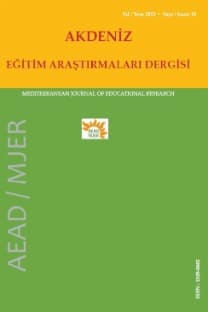Ortaöğretim Öğrencilerinin Sanal Dünyalarının Günlük Hayatlarına Yansımaları Üzerine Bir Durum Çalışması
Bu çalışmanın amacı; Z kuşağı olarak tanımlanan 2000 yılı ve sonrasında doğan ortaöğretim öğrencilerinin söylemlerinde kullandıkları dili ve kullandıkları bu dili kaynağını tespit etmektir. Araştırma, nitel araştırma yöntemlerinden durum çalışması deseniyle desenlemiştir. Bu araştırmanın örneklem grubunu İstanbul'un Avrupa yakasında bir lisede öğrenim görmekte olan 15-17 yaş grubundaki 32 erkek ve 30 kız öğrenci oluşturmaktadır. Araştırmada örneklem grubunun belirlenmesinde tipik durum örneklemesi yöntemi kullanılmıştır. Araştırmanın verileri, örneklem grubunu oluşturan toplam 62 öğrenci ile görüşülerek toplanmıştır. Araştırma verileri görüşme soruları yoluyla elde edilmiş olup, elde edilen veriler betimsel analiz yoluyla temalara ayrılarak kodlanmıştır. Araştırmada öğrencilerden günlük hayatta ve kendi aralarındaki konuşmalarda kullandıkları kelimeler ve bu kelimelerin anlamlarını yazmaları istenmiştir. Öğrencilerden alınan kelime listeleri tabloya dökülmüştür. Daha sonra öğrencilerle beş sorudan oluşan kısa bir görüşme yapılmış ve bu görüşmede öğrencilerin bu kelimeleri ilk nereden duydukları, bu kelimeleri en çok nerelerde ve kimlerle kullandıkları, bu kelimeleri kullandıklarında yakın çevrelerinin tepkilerinin neler olduğu sorulmuştur. Öğrencilerin verdikleri cevaplar tablolaştırılarak yorumlanmıştır. Z kuşağı olarak tanımlanan bu yaş grubundaki öğrencilerin sanal dünya ve buna bağlı olarak gelişen sosyal medyadan birçok yabancı kelimeyi anadilleri içinde doğal süreçte fark etmeden kullandıkları tespit edilmiştir. Ayrıca öğrencilerin bu kelimelerden bazılarının Türkçe karşılıklarını hiçbir şekilde bilmedikleri de araştırmanın sonuçları arasında yer almaktadır.
A Case Study on the Reflections of the Secondary School Students to the Daily Life of the Virtual World
The purpose of this study is to identify the language and the language source they use in the discourse of the secondary school students born in the year 2000 and after, defined as the Z generation. The research is structured by the case study pattern of qualitative research methods. The sample group of this research consists of 32 male and 30 female students in the 15-17 age group who are studying in a high school in Istanbul. Typical case sampling method was used in determining the sample group in the research. The data of the study were collected by interviewing 62 students constituting the sample group. The research data was obtained through interview questions and the data obtained were coded by analyzing the content by theme. Students were asked to write the words they used in daily life and in their conversations and the meanings of these words. The word lists from the students are put on the table. Then, a short interview consisting of five questions was made by the students and the students were asked where they first heard these words, where they used those words most often and who used them, and what the reactions of the near surroundings were when they used these words. The answers given by the students are tabled and interpreted. It has been determined that the students in this age group, defined as Z belts, use many foreign words in the natural world from the virtual world and the social media that develops accordingly. Moreover, the results of researching the students do not know the Turkish equivalents of some of these words in any way.
___
- Arabacı İ. B. ve Polat, M. (2013). Dijital Yerliler, Dijital Göçmenler ve Sınıf Yönetimi. Elektronik Sosyal Bilimler Dergisi. 12(47), s. 11-20.
- Altuntuğ, N. (2012). Kuşaktan Kuşağa Tüketim Olgusu ve Geleceğin Tüketici Profili. Organizasyon ve Yönetim Bilimleri Dergisi. 4(1).
- Bilgiç, H. G., Duman D., Seferoğlu, S. S. (2011). Dijital Yerlilerin Özellikleri ve Çevrim içi Ortamların Tasarlanmasındaki Etkileri. Akademik Bilişim.
- Creswell, J. W. (2013). Nitel Araştırma Yöntemleri. Mesut Bütün, Selçuk Beşir Demir (çev.). Ankara: Siyasal Yayın Dağıtım.
- Çetin, M. ve Özgiden, H. (2013). Dijital Kültür Sürecinde Dijital Yerliler Ve Dijital Göçmenlerin Twitter Kullanım Davranışları Üzerine Bir Araştırma. Gümüşhane Üniversitesi İletişim Fakültesi Elektronik Dergisi. 2(1), s. 172-189.
- Eşgi, N. (2013). Dijital Yerli Çocukların ve Dijital Göçmen Ebeveynlerinin İnternet Bağımlılığına İlişkin Algılarının Karşılaştırılması. Hacettepe Üniversitesi Eğitim Fakültesi Dergisi (H. U. Journal of Education). 28(3). 181-194
- ISSN: 1309-0682
- Yayın Aralığı: Yılda 4 Sayı
- Başlangıç: 2008
- Yayıncı: Tayfun Taşbilek
